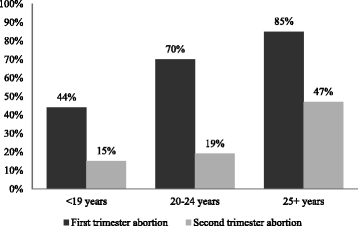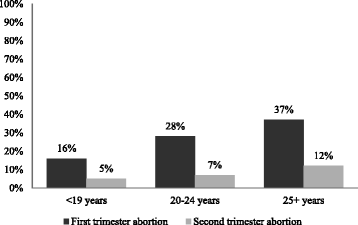Determinants of first and second trimester induced abortion - results from a cross-sectional study taken place 7 years after abortion law revisions in Ethiopia
- PMID: 25622947
- PMCID: PMC4307197
- DOI: 10.1186/s12884-014-0416-9
Determinants of first and second trimester induced abortion - results from a cross-sectional study taken place 7 years after abortion law revisions in Ethiopia
Abstract
Background: In 2005 Ethiopia took the important step to protect women's reproductive health by liberalizing the abortion law. As a result women were given access to safe pregnancy termination in first and second trimester. This study aims to describe socio-economic characteristics and contraceptive experience among women seeking abortion in Jimma, Ethiopia and to describe determinants of second trimester abortion.
Methods: A cross-sectional study conducted October 2011 - April 2012 in Jimma Town, Ethiopia among women having safely induced abortion and women having unsafely induced abortion. In all 808 safe abortion cases and 21 unsafe abortion cases were included in the study. Of the 829 abortions, 729 were first trimester and 100 were second trimester abortions. Bivariate and multivariate logistic regressions were used to determine risk factors associated with second trimester abortion. The associations are presented as odds ratios (OR) with 95% confidential intervals. Age stratified analyses of contraceptive experience among women with first and second trimester abortions are also presented.
Results: Socio-economic characteristics associated with increased ORs of second trimester abortion were: age < 19 years, being single, widowed or divorced, attending school, being unemployment, being nullipara or para 3+, and having low education. The contraceptive prevalence rate varied across age groups and was particularly low among young girls and young women experiencing second trimester abortion where only 15% and 19% stated they had ever used contraception.
Conclusion: Young age, poor education and the prospect of single parenthood were associated with second trimester abortion. Young girls and young women were using contraception comparatively less often than older women. To ensure women full right to control their fertility in the setting studied, modern contraception should be made available, accessible and affordable for all women, regardless of age.
Figures
Similar articles
-
Determinants and Outcome of Safe Second Trimester Medical Abortion at Jimma University Medical Center, Southwest Ethiopia.J Pregnancy. 2019 Jul 7;2019:4513827. doi: 10.1155/2019/4513827. eCollection 2019. J Pregnancy. 2019. PMID: 31360549 Free PMC article. Clinical Trial.
-
Induced second trimester abortion and associated factors in Amhara region referral hospitals.Biomed Res Int. 2015;2015:256534. doi: 10.1155/2015/256534. Epub 2015 Mar 30. Biomed Res Int. 2015. PMID: 25918704 Free PMC article.
-
Risk factors associated with presenting for abortion in the second trimester.Obstet Gynecol. 2006 Jan;107(1):128-35. doi: 10.1097/01.AOG.0000189095.32382.d0. Obstet Gynecol. 2006. PMID: 16394050
-
Utilization and its factors of post abortion modern contraceptive in Ethiopia: a systematic review and meta-analysis.Reprod Health. 2021 Jul 3;18(1):143. doi: 10.1186/s12978-021-01195-8. Reprod Health. 2021. PMID: 34217317 Free PMC article.
-
Multiple induced abortions: Danish experience.Patient Educ Couns. 1997 May;31(1):83-9. doi: 10.1016/s0738-3991(97)01012-4. Patient Educ Couns. 1997. PMID: 9197806 Review.
Cited by
-
Adolescent abortion care trajectories and safety in Ethiopia, Malawi, and Zambia: A comparative mixed methods study.PLOS Glob Public Health. 2025 May 6;5(5):e0004469. doi: 10.1371/journal.pgph.0004469. eCollection 2025. PLOS Glob Public Health. 2025. PMID: 40327635 Free PMC article.
-
Delays in seeking abortion and its determinants among reproductive-age women based on the Ethiopian Demographic and health survey.Heliyon. 2024 Sep 26;10(19):e38477. doi: 10.1016/j.heliyon.2024.e38477. eCollection 2024 Oct 15. Heliyon. 2024. PMID: 39430523 Free PMC article.
-
Induced Second Trimester Abortion and Associated Factors at Debre Markos Referral Hospital: Cross-Sectional Study.Womens Health (Lond). 2020 Jan-Dec;16:1745506520929546. doi: 10.1177/1745506520929546. Womens Health (Lond). 2020. PMID: 32578513 Free PMC article.
-
Epidemiology of second trimester induced abortion in Ethiopia: a systematic review and meta-analysis.Front Glob Womens Health. 2025 Apr 28;6:1452114. doi: 10.3389/fgwh.2025.1452114. eCollection 2025. Front Glob Womens Health. 2025. PMID: 40357003 Free PMC article.
-
Playing it Safe: Legal and Clandestine Abortions Among Adolescents in Ethiopia.J Adolesc Health. 2018 Jun;62(6):729-736. doi: 10.1016/j.jadohealth.2017.12.015. Epub 2018 Mar 14. J Adolesc Health. 2018. PMID: 29550154 Free PMC article.
References
-
- Facts on abortion in Africa. in brief. 2012. http://www.guttmacher.org/pubs/IB_AWW-Africa.pdf.
-
- Singh S, Wulf D, Hussain R, Bankole A, Sedgh G: Abortion Worldwide: A Decade of Uneven Progress. New York; 2009.
-
- Jewkes R, Rees H. Dramatic decline in abortion mortality due to the choice on termination of pregnancy act. S Afr Med J. 2005;95(4):250. - PubMed
Publication types
MeSH terms
LinkOut - more resources
Full Text Sources
Other Literature Sources
Medical
Research Materials
Miscellaneous




